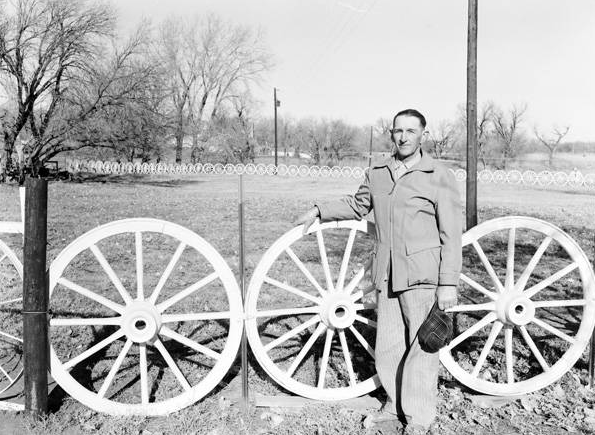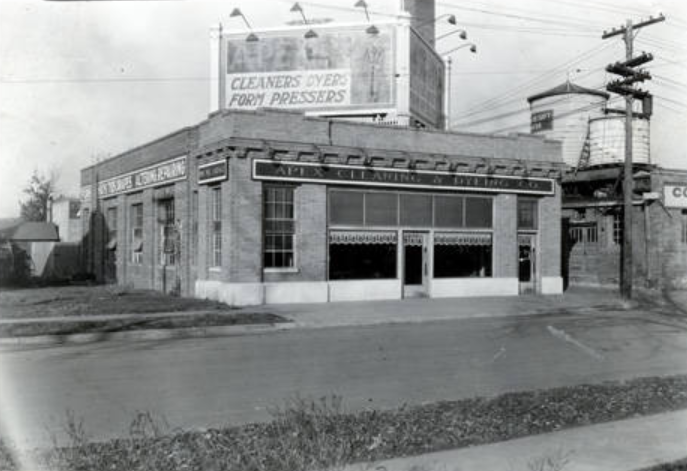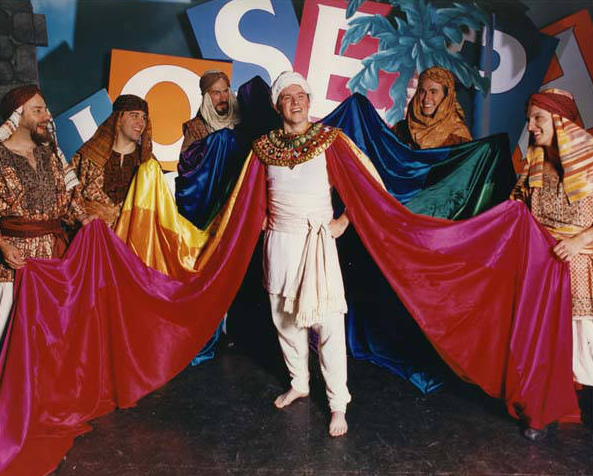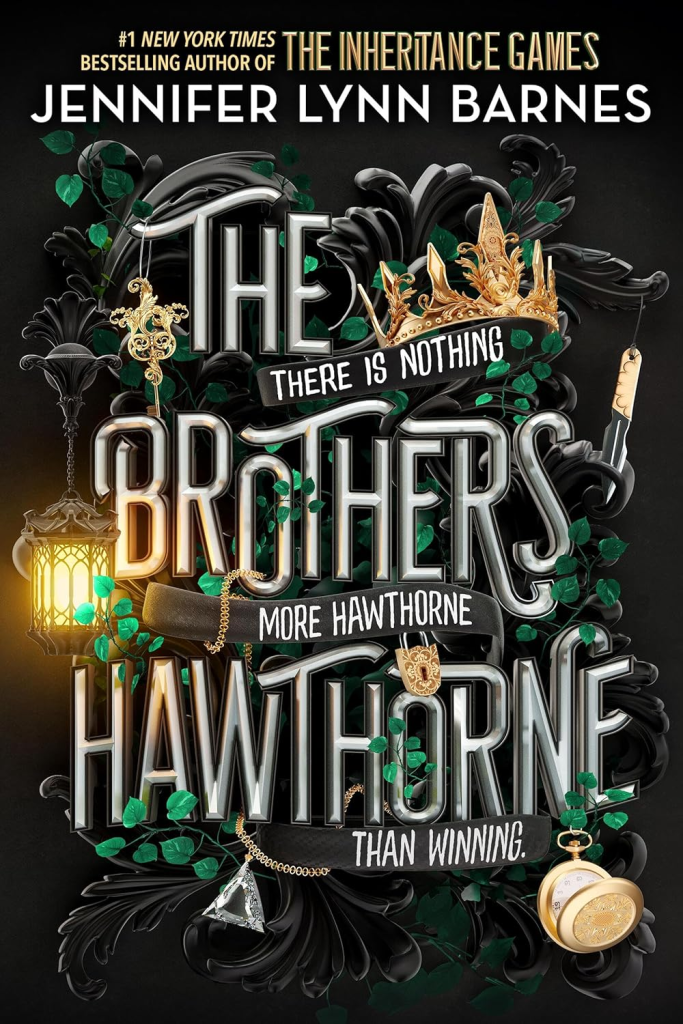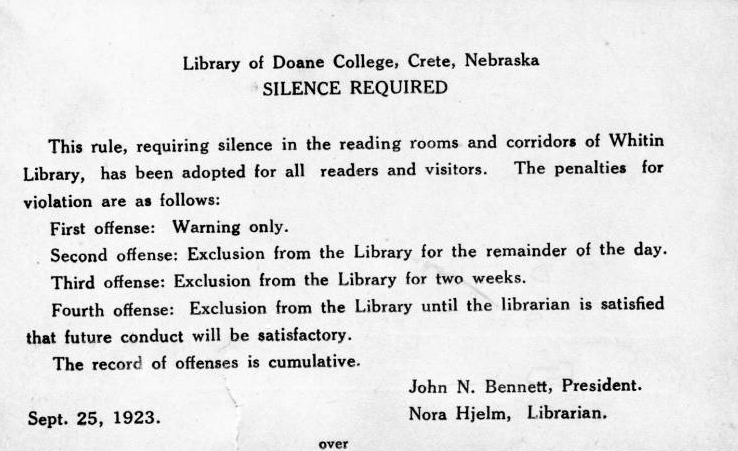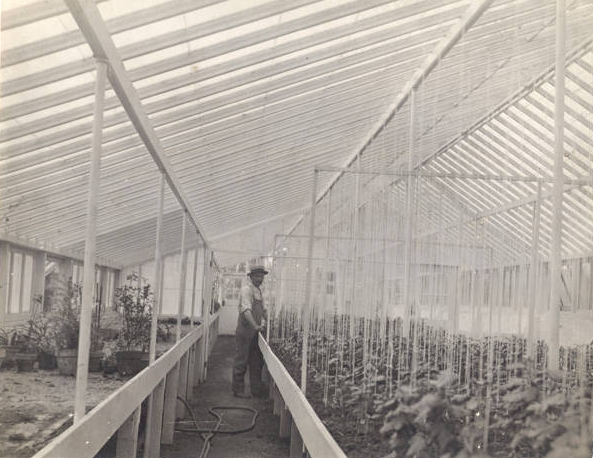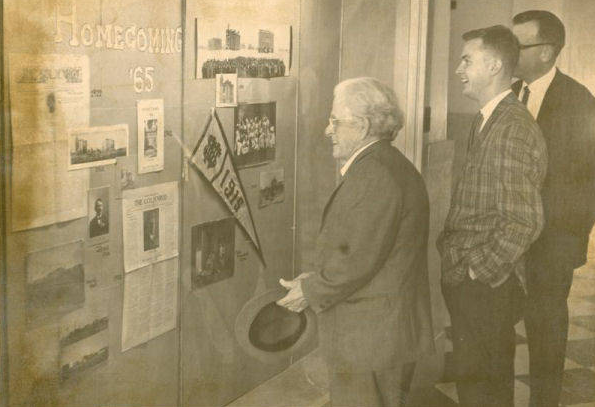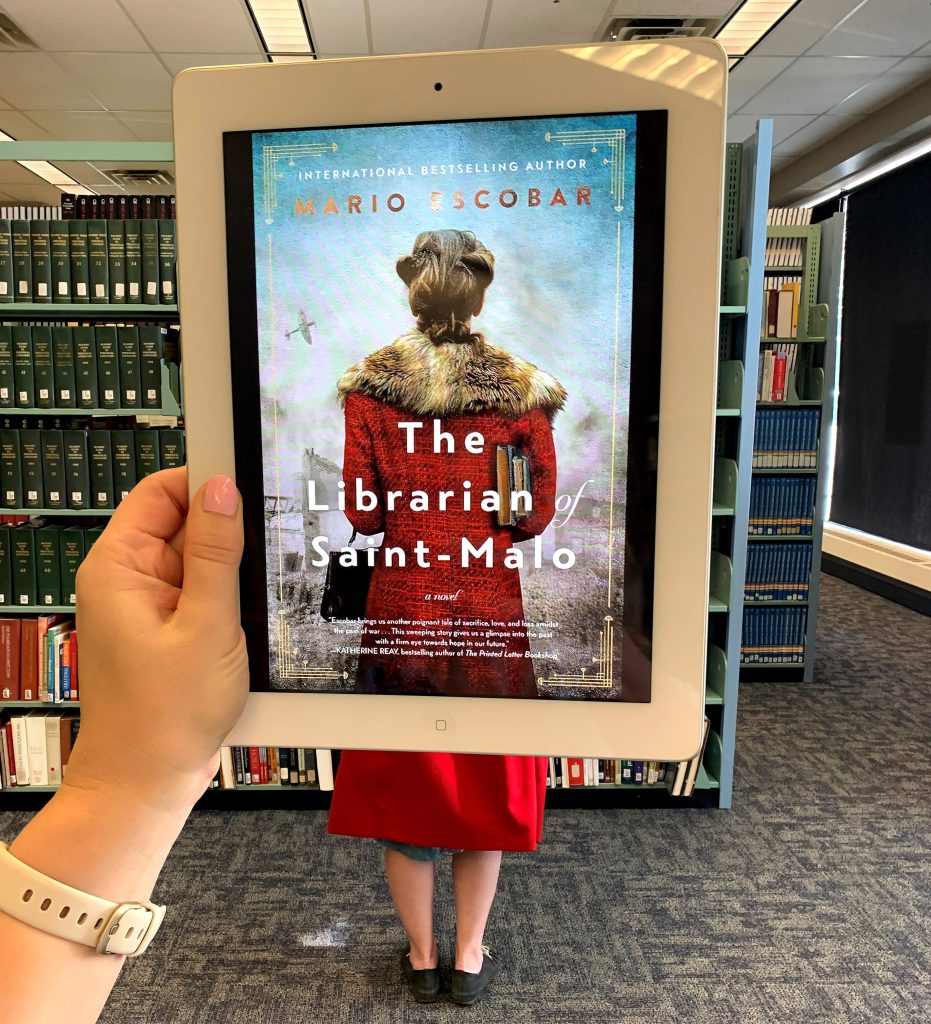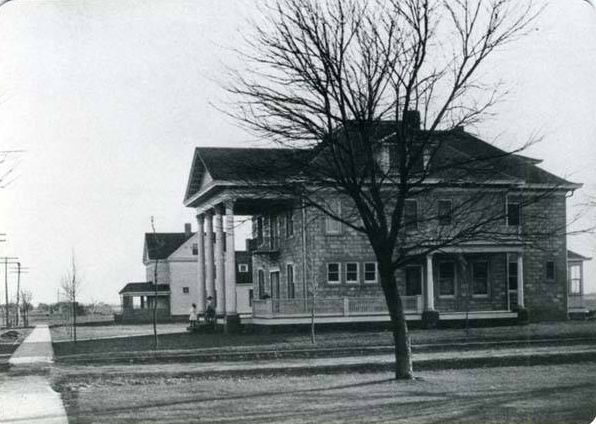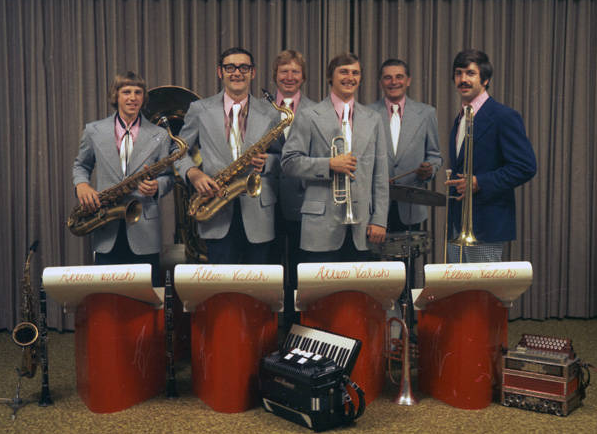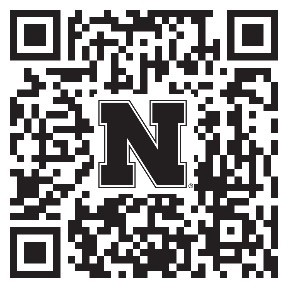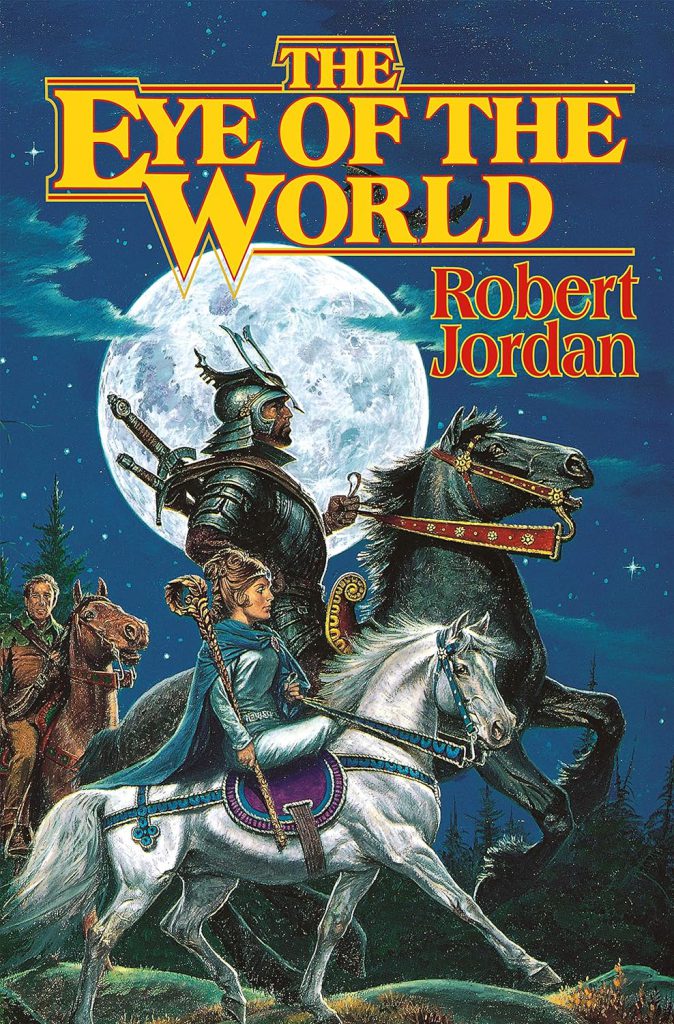Search the Blog
Categories
- Books & Reading
- Broadband Buzz
- Census
- Education & Training
- General
- Grants
- Information Resources
- Library Management
- Nebraska Center for the Book
- Nebraska Memories
- Now hiring @ your library
- Preservation
- Pretty Sweet Tech
- Programming
- Public Library Boards of Trustees
- Public Relations
- Talking Book & Braille Service (TBBS)
- Technology
- Uncategorized
- What's Up Doc / Govdocs
- Youth Services
Archives
Subscribe
Category Archives: General
Throwback Thursday: Ernie Nozicka
Happy #ThrowbackThursday from Nebraska Memories!
This week, we have a 3″ x 5″ on-site photograph of Ernie Nozicka at his home near Bruno, Nebraska. Ernie was born near Bruno on June 11, 1898, the son of Matej and Frances Smejkla Nozicka. He married Rose Krepcik and after she died in 1972, married Julia Strudl. He farmed northeast of Bruno for 60 years and his place was known as the “Wagon Wheel Farm”. He had over 300 white wagon wheels with fencing lining both sides of the lane to his home and along the main road north of his farm. He started farming with six head of horses and never owned a tractor. In the 1930’s and 1940’s he broke horses for riding and farm work. He supplemented his income by working as the township overseer of Skull Creek. He was also a real estate broker and served on the Bruno School Board. He entertained people with his accordion music for over 75 years and often drove a team of horses or mules with a decorated buggy in local parades.
This 1950’s image is published as part of the Boston Studio Project and is owned by the Thorpe Opera House Foundation. The Boston Studio Collection consists of over 68,000 negatives that record life in and around David City, Nebraska from 1893 to 1979.
If you like history, check out the Nebraska Memories archive!
The Nebraska Memories archive is brought to you by the Nebraska Library Commission. If your institution is interested in participating in Nebraska Memories, see http://nlc.nebraska.gov/nebraskamemories/participation.aspx for more information.
#BookFaceFriday “El Conejito Knuffle” by Mo Willems
¿Dónde está el #BookFaceFriday?
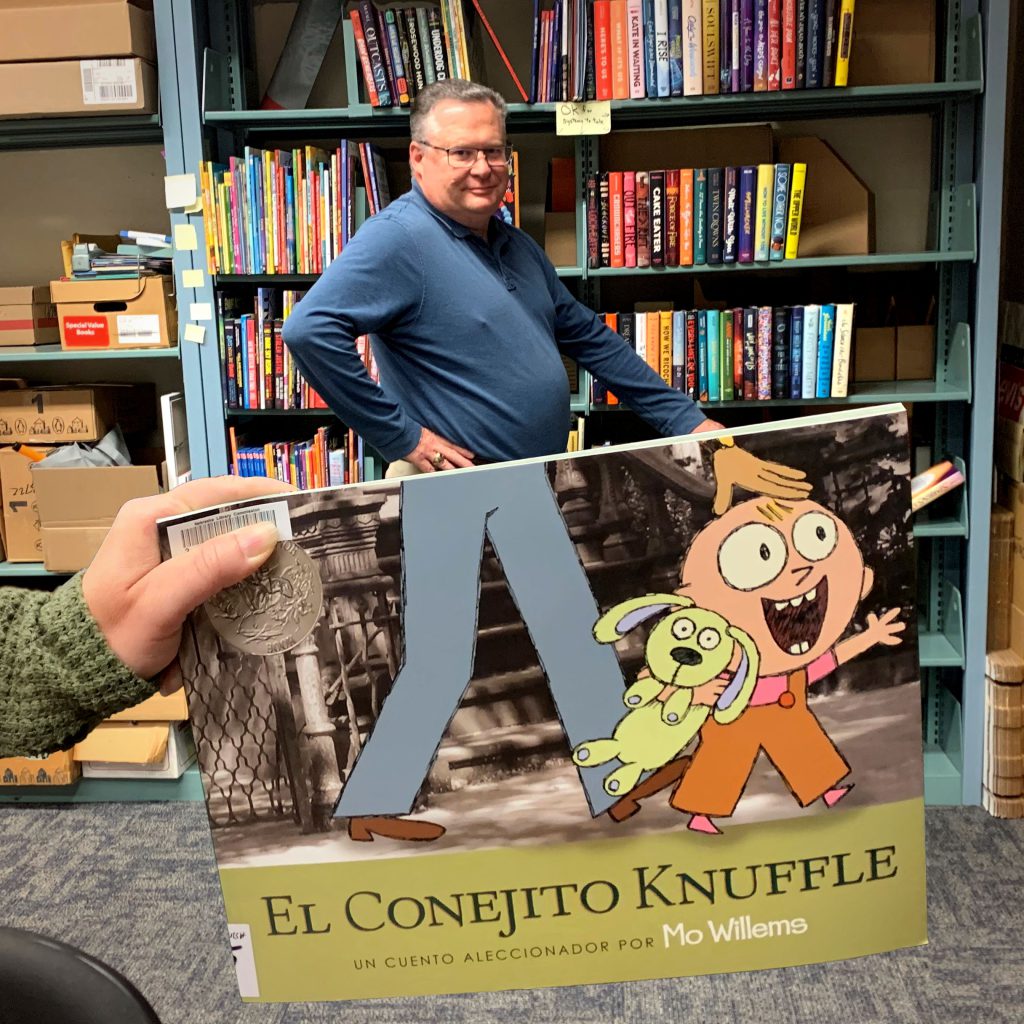
No need to retrace your steps to find this #BookFaceFriday! This week, we are highlighting one of the new Spanish language titles recently added to our Book Club Kit Collection, “El Conejita Knuffle” by Mo Willems (Hyperion Books for Children, 2007).
Browse all available titles using the keyword “Spanish” in the keyword search field. For kits that were already available in English, the title will be shown in English; for titles only available in Spanish, the Spanish title will be shown. For both types of kits, the number of Spanish copies is listed at the bottom of the title’s record. At the present time, most of our new Spanish-language kits are geared towards younger readers, but we hope to expand this selection in the future.“En esta combinación de unos expresivos dibujos de c
mic con preciosas fotografías de Brooklyn, Nueva York, el autor de ¡No dejes que la paloma condeuzca el autobús! crea un cuento brillante de la vida real sobre lo que pasa cuando Papá es el que manda, y todo sale humorística ya terriblemente mal.
Using a pastiche of muted black and white photography and expressive illustrations, this stunning book tells a brilliantly true-to-life tale about what happens when Daddy’s in charge and things go terribly, hilariously wrong..”
– Back cover
Book Club Kits Rules for Use
- These kits can be checked out by the librarians of Nebraska libraries and media centers.
- Circulation times are flexible and will be based upon availability. There is no standard check-out time for book club kits.
- Please search the collection to select items you wish to borrow and use the REQUEST THIS KIT icon to borrow items.
- Contact the Information Desk at the Library Commission if you have any questions: by phone: 800/307-2665, or by email: Information Services Team
Love this #BookFace & reading? Check out our past #BookFaceFriday photos on the Nebraska Library Commission’s Facebook page!
Posted in Books & Reading, General
Tagged Book Club Kits, bookface, bookfacefriday, El Conejita Knuffle, Knuffle Bunny, Mo Willems, Reading, Spanish
Leave a comment
Throwback Thursday: Apex Cleaning & Dyeing Company
Happy #ThrowbackThursday from Nebraska Memories!
This week, we have a 6 1/2″ x 4 1/2″ black and white photograph from 1928, showing the one-story brick building that housed Apex Cleaning & Dyeing Co.
Apex Cleaning built its main office and plant at 123 S. 23rd Street, Lincoln, in 1923. P. M. Plamondon was president of the Apex Cleaning & Dyeing Co. In addition to its main office building, the company had an “Uptown Office” At at 326 S. 13th, a south office at 1520 S. 17th and a north office at 1427 N. 33rd.
This week’s #throwback is published and owned by the Jane Pope Geske Heritage Room of Nebraska Authors. The collection of the Heritage Room at Lincoln City Libraries includes digitized items from the Rudolph Umland Papers and images that were scanned from an album titled “Lincoln, Nebraska: A Photograph Album of Business Buildings.”
Check out the full collection on the Nebraska Memories archive.
The Nebraska Memories archive is brought to you by the Nebraska Library Commission. If your institution is interested in participating in Nebraska Memories, see http://nlc.nebraska.gov/nebraskamemories/participation.aspx for more information.
Book Briefs: New University of Nebraska Press Books at the Nebraska Publications Clearinghouse
The Nebraska Publications Clearinghouse receives documents every month from all Nebraska state agencies, including the University of Nebraska Press (UNP). Each month we will be showcasing the UNP books that the Clearinghouse has received.
UNP books, as well as all Nebraska state documents, are available for checkout by libraries and librarians for their patrons.
Here are the UNP books the Clearinghouse received in September and October, 2023:
Almost Somewhere : Twenty-Eight Days on the John Muir Trail, by Suzanne Roberts. Series: Outdoor Lives.
Winner of the National Outdoor Book Award in Outdoor Literature
It was 1993, Suzanne Roberts had just finished college, and when her friend suggested they hike California’s John Muir Trail, the adventure sounded like the perfect distraction from a difficult home life and thoughts about the future. But she never imagined that the twenty-eight-day hike would change her life. Part memoir, part nature writing, part travelogue, Almost Somewhere is Roberts’s account of that hike.
John Muir wrote of the Sierra Nevada as a “vast range of light,” and that was exactly what Roberts was looking for. But traveling with two girlfriends, one experienced and unflappable and the other inexperienced and bulimic, she quickly discovered that she needed a new frame of reference. Her story of a month in the backcountry—confronting bears, snowy passes, broken equipment, injuries, and strange men—is as much about finding a woman’s way into outdoor experience as it is about the natural world Roberts so eloquently describes. Candid and funny, and finally, wise, Almost Somewhere not only tells the whimsical coming-of-age story of a young woman ill-prepared for a month in the mountains but also reflects a distinctly feminine view of nature.
This new edition includes an afterword by the author looking back on the ways both she and the John Muir Trail have changed over the past thirty years, as well as book club and classroom discussion questions and photographs from the trip.
The Complete Letters of Henry James, 1887-1888, Volume 2, Edited by Michael Anesko and Greg W. Zacharias, and Katie Sommer. Series: The Complete Letters of Henry James
This second volume of The Complete Letters of Henry James, 1887–1888 contains 182 letters, of which 120 are published for the first time, written from late December 1887 to November 19, 1888. These letters continue to mark Henry James’s ongoing efforts to care for his sister, develop his work, strengthen his professional status, build friendships, engage timely political and economic issues, and maximize his income. James details work on The Aspern Papers, The Reverberator, Partial Portraits, and The Tragic Muse. This volume opens with some of James’s social visits, includes the death of longtime friend Lizzie Boott, and concludes with James on the Continent.
Ecologies of Imperialism in Algeria, by Brock Cutler. Series: France Overseas: Studies in Empire and Decolonization.
Between 1865 and 1872 widespread death and disease unfolded amid the most severe ecological disaster in modern North African history: a plague of locusts destroyed crops during a disastrous drought that left many Algerians landless and starving. The famine induced migration that concentrated vulnerable people in unsanitary camps where typhus and cholera ran rampant. Before the rains returned and harvests normalized, some eight hundred thousand Algerians had died.
In Ecologies of Imperialism in Algeria Brock Cutler explores how repeated ecosocial divisions across an expansive ecosystem produced modern imperialism in nineteenth-century Algeria. Massive ecological crises—cultural as well as natural—cleaved communities from their homes, individuals from those communities, and society from its typical ecological relations. At the same time, the relentless, albeit slow-moving crises of ongoing settler colonialism and extractive imperial capitalism cleaved Algeria to France in a new way. Ecosocial divisions became apparent in performances of imperial power: officials along the Algerian-Tunisian border compulsively repeated narratives of “transgression” that over decades made the division real; a case of poisoned bread tied settlers in Algiers to Paris; Morocco-Algeria border violence exposed the exceptional nature of imperial sovereignty; a case of vagabondage in Oran evoked colonial gender binaries. In each case, factors in the broader ecosystem were implicated in performances of social division, separating political entities from each other, human from nature, rational from irrational, and women from men. Although these performances take place in the nineteenth-century Maghrib, the process they describe goes beyond those spatial and temporal limits—across the field of modern imperialism to the present day.
Encountering Palestine : Un/Making Spaces of Colonial Violence, Edited by Mark Griffiths and Mikko Joronen. Series: Cultural Geographies + Rewriting the Earth.
Encountering Palestine: Un/making Spaces of Colonial Violence, edited by Mark Griffiths and Mikko Joronen, sits at the intersection of cultural and political geographies and offers innovative reflections on power, colonialism, and anti-colonialism in contemporary Palestine and Israel. Organized around the theme of encountering and focusing on the ways violence and struggle are un/made in the encounter between the colonizer and colonized, the essays focus on power relations as they manifest in cultural practices and everyday lives in anti/colonial Palestine.
Covering numerous sites in Gaza, the West Bank, East Jerusalem, and Israel, Encountering Palestine addresses a range of empirical topics—from marriage and queer aesthetics to policing, demolition, armament failure, and violence. The contributors utilize diverse theoretical frameworks, such as hyperreality, settler capitalism, intimate biopolitics, and politics of vulnerability, to help us better understand the cultural making and unmaking of colonial and anti-colonial space in Palestine. Encountering Palestine asks us to rethink how colonialism and power operate in Palestine, the ways Palestinians struggle, and the lifeways that constantly encounter, un/make, and counter the spaces of colonial violence.
Galloping Gourmet : Eating and Drinking With Buffalo Bill, by Steve Friesen.
Galloping Gourmet explores an unfamiliar side of a familiar character in American history, William F. “Buffalo Bill” Cody. In this entertaining narrative Steve Friesen explores the evolving role of eating and drinking in Buffalo Bill’s life (1846–1917). Friesen starts with Buffalo Bill’s culinary roots on the American Plains, eating simple foods such as cornbread, fried “yellow-legged” chicken, and hardtack. Buffalo Bill discovered gourmet dining while leading buffalo-hunting expeditions and scouting. As his fame increased, so did his desire and opportunities for fine dining: his early show business career allowed him to dine at some of the best restaurants in the country.
Friesen examines the creation of Buffalo Bill’s Wild West Show in 1883, in which Cody introduced his diverse cast of employees to dining that equaled America’s best restaurants. One newspaper reporter observed that “Colonel Cody displays no more care about anything than the proper feeding of horse and man.” Cody opened the first Mexican restaurant east of the Mississippi and introduced American foodways to Europe. Equally comfortable eating around a campfire on the plains or at Delmonico’s in New York City, he also dined with leading celebrities of his day. In the final section Friesen addresses the controversies surrounding Cody’s drinking, his death, and his ongoing culinary legacy. Galloping Gourmet includes an appendix of more than thirty annotated period recipes.
Godfall : a Novel, by Van Jensen. Series: Flyover Fiction.
When a massive asteroid hurtles toward Earth, humanity braces for annihilation—but the end doesn’t come. In fact, it isn’t an asteroid but a three-mile-tall alien that drops down, seemingly dead, outside Little Springs, Nebraska. Dubbed “the giant,” its arrival transforms the red-state farm town into a top-secret government research site and major metropolitan area, flooded with soldiers, scientists, bureaucrats, spies, criminals, conspiracy theorists—and a murderer.
As the sheriff of Little Springs, David Blunt thought he’d be keeping the peace among the same people he’d known all his life, not breaking up chanting crowds of conspiracy theorists in tiger masks or struggling to control a town hall meeting about the construction of a mosque. As a series of brutal, bizarre murders strikes close to home, Blunt throws himself into the hunt for a killer who seems connected to the Giant. With bodies piling up and tensions in Little Springs mounting, he realizes that in order to find the answers he needs, he must first reconcile his old worldview with the town he now lives in—before it’s too late.
The Grapes of Conquest : Race, Labor, and the Industrialization of California Wine, 1769-1920, by Julia Ornelas-Higdon. Series: At Table.
California’s wine country conjures images of pastoral vineyards and cellars lined with oak barrels. As a mainstay of the state’s economy, California wines occupy the popular imagination like never before and drive tourism in famous viticultural regions across the state. Scholars know remarkably little, however, about the history of the wine industry and the diverse groups who built it. In fact, contemporary stereotypes belie how the state’s commercial wine industry was born amid social turmoil and racialized violence in eighteenth- and nineteenth-century California.
In The Grapes of Conquest Julia Ornelas-Higdon addresses these gaps in the historical narrative and popular imagination. Beginning with the industry’s inception at the California missions, Ornelas-Higdon examines the evolution of wine growing across three distinct political regimes—Spanish, Mexican, and American—through the industry’s demise after Prohibition. This interethnic study of race and labor in California examines how California Natives, Mexican Californios, Chinese immigrants, and Euro-Americans came together to build the industry. Ornelas-Higdon identifies the birth of the wine industry as a significant missing piece of California history—one that reshapes scholars’ understandings of how conquest played out, how race and citizenship were constructed, and how agribusiness emerged across the region. The Grapes of Conquest unearths the working-class, multiracial roots of the California wine industry, challenging its contemporary identity as the purview of elite populations.
The Incarceration of Native American Women : Creating Pathways to Wellness and Recovery Through Gentle Action Theory, by Carma Corcoran. Series: New Visions in Native American and Indigenous Studies.
In The Incarceration of Native American Women, Carma Corcoran examines the rising number of Native American women being incarcerated in Indian Country. With years of experience as a case management officer, law professor, consultant to tribal defenders’ offices, and workshop leader in prisons, she believes this upward trajectory of incarceration continues largely unacknowledged and untended. She explores how a combination of F. David Peat’s gentle action theory and the Native traditional ways of knowing and being could heal Native American women who are or have been incarcerated.
Colonization and the historical trauma of Native American incarceration runs through history, spanning multiple generations and including colonial wartime imprisonment, captivity, Indian removal, and boarding schools. The ongoing ills of childhood abuse, domestic violence, sexual assault, and drug and alcohol addiction and the rising number of suicides are indicators that Native people need healing. Based on her research and work with Native women in prisons, Corcoran provides a theory of wellness and recovery that creates a pathway for meaningful change. The Incarceration of Native American Women offers students, academics, social workers, counselors, and those in the criminal justice system a new method of approach and application while providing a deeper understanding of the cultural and historical experiences of Native Americans in relation to criminology.
Nebraska Volleyball : the Origin Story, by John Mabry.
When Title IX was enacted in 1972, the University of Nebraska volleyball program, like many across the country, received a fraction of the funding and attention given to the school’s mighty football program. The players had to organize a run from Lincoln to Omaha to raise money for uniforms. The women were asked to wait their turn to use the weight room. Today the Nebraska women’s volleyball team is one of the sport’s most decorated programs—with more career wins than any other program and five NCAA National Championships—and draws standing-room-only crowds at home games in the 8,000-seat Devaney Center.
Nebraska Volleyball is the first book to recount how volleyball took hold at Nebraska, through Pat Sullivan, the team’s first coach; through such early figures as Cathy Noth, a decorated player and later an assistant coach into the 1990s; through Terry Pettit, who coached the team for twenty-three seasons and led it to its first National Championship in 1995; and through John Cook, who took over as head coach in 2000. John Mabry highlights the small Nebraska towns that have sent some of the best players to the program and helped build statewide support for the team. Public television helped too, with its power to broadcast games early on and thus build a following across the state.
The success of Nebraska’s volleyball program is one of the greatest stories in sports. As Karch Kiraly, head coach for the U.S. National Women’s Volleyball Team, said: “If you want to learn about women’s college volleyball, your first stop has to be Lincoln, Nebraska.”
Of Love and War : Pacific Brides of World War II, by Angela Wanhalla. Series: Studies in Pacific Worlds.
Between 1942 and 1945 more than two million servicemen occupied the southern Pacific theater, the majority of whom were Americans in service with the U.S. Army, Navy, Air Force, and Marines. During the occupation, American servicemen married approximately 1,800 women from New Zealand and the island Pacific, creating legal bonds through marriage and through children. Additionally, American servicemen fathered an estimated four thousand nonmarital children with Indigenous women in the South Pacific Command Area.
In Of Love and War Angela Wanhalla details the intimate relationships forged during wartime between women and U.S. servicemen stationed in the South Pacific, traces the fate of wartime marriages, and addresses consequences for the women and children left behind. Paying particular attention to the experiences of women in New Zealand and in the island Pacific—including Tonga, Fiji, Samoa, and the Cook Islands—Of Love and War aims to illuminate the impact of global war on these women, their families, and Pacific societies. Wanhalla argues that Pacific war brides are an important though largely neglected cohort whose experiences of U.S. military occupation expand our understanding of global war. By examining the effects of American law on the marital opportunities of couples, their ability to reunite in the immediate postwar years, and the citizenship status of any children born of wartime relationships, Wanhalla makes a significant contribution to a flourishing scholarship concerned with the intersections between race, gender, sexuality, and militarization in the World War II era.
Rise Up! : Indigenous Music in North America, by Craig Harris.
Music historian Craig Harris explores more than five hundred years of Indigenous history, religion, and cultural evolution in Rise Up! Indigenous Music in North America. More than powwow drums and wooden flutes, Indigenous music intersects with rock, blues, jazz, folk music, reggae, hip-hop, classical music, and more. Combining deep research with personal stories by nearly four dozen award-winning Indigenous musicians, Harris offers an eye-opening look at the growth of Indigenous music.
Among a host of North America’s most vital Indigenous musicians, the biographical narratives include new and well-established figures such as Mildred Bailey, Louis W. Ballard, Cody Blackbird, Donna Coane (Spirit of Thunderheart), Theresa “Bear” Fox, Robbie Robertson, Buffy Sainte-Marie, Joanne Shenandoah, DJ Shub (Dan General), Maria Tallchief, John Trudell, and Fawn Wood.
Settler Aesthetics : Visualizing the Spectacle of Originary Moments in The New World, by Mishuana Goeman. Series: Indigenous Films.
In Settler Aesthetics, an analysis of renowned director Terrence Malick’s 2005 film, The New World, Mishuana Goeman examines the continuity of imperialist exceptionalism and settler-colonial aesthetics. The story of Pocahontas has thrived for centuries as a cover for settler-colonial erasure, destruction, and violence against Native peoples, and Native women in particular. Since the romanticized story of the encounter and relationship between Pocahontas and Captain John Smith was first published, it has imprinted a whitewashed historical memory into the minds of Americans.
As one of the most enduring tropes of imperialist nostalgia in world history, Renaissance European invasions of Indigenous lands by settlers trades in a falsified “civilizational discourse” that has been a focus in literature for centuries and in films since their inception. Ironically, Malick himself was a symbol of the New Hollywood in his early career, but with The New World he created a film that serves as a buttress for racial capitalism in the Americas. Focusing on settler structures, the setup of regimes of power, sexual violence and the gendering of colonialism, and the sustainability of colonialism and empires, Goeman masterfully peels away the visual layers of settler logics in The New World, creating a language in Native American and Indigenous studies for interpreting visual media.
The Sonoran Dynasty in Mexico : Revolution, Reform, and Repression, by Jürgen Buchenau. Series: Confluencias.
Two generals from the northwestern state of Sonora, Álvaro Obregón and Plutarco Elías Calles, dominated Mexico between 1920 and 1934, having risen to prominence in the course of the Mexican Revolution. Torn between popular demands for ending the privileges of wealthy foreign investors and opposition by a hawkish U.S. administration and enemies at home, the two generals and their allies from their home state mixed radical rhetoric with the accommodation of entrenched interests.
In The Sonoran Dynasty in Mexico Jürgen Buchenau tells the story of this ruling group, which rejected the Indigenous and Catholic past during the decades of the revolution and aimed to reinvent Mexico along the lines of the modern and secular societies in western Europe and the United States. In addition to Obregón and Calles, the Sonoran Dynasty included Adolfo de la Huerta and Abelardo L. Rodríguez, four Sonorans among six presidents in less than two decades. Although the group began with the common aims of nationalism, modernization, central political control, and enrichment, Buchenau argues that this group progressively fell apart in a series of bloody conflicts that reflected broader economic, political, and social disagreements. By analyzing the dynasty from its origins through its eventual downfall, Buchenau presents an innovative look at the negotiation of power and state formation in revolutionary Mexico.
Ted Kooser : More Than a Local Wonder, by Carla Ketner, illustrated by Paula Wallace.
Long before Ted Kooser won a Pulitzer Prize for Poetry, served as the U.S. Poet Laureate, and wrote award-winning books for children, he was an unathletic child growing up in Iowa, yearning to fit in. Young Teddy found solace in stories, and one specific book, Robert McCloskey’s Lentil, inspired him to become a writer. As a child and later, while working in the insurance industry, Ted honed his craft and unique style as he wrote about the people and places of the rural Midwest. Ted Kooser: More Than a Local Wonder celebrates the power of stories and of finding oneself through words.
Washington State Politics and Government, by T.M. Sell. Series: Politics and Governments of the American States.
In the twenty-first century, as many candidates actively campaign against the very government they seek to serve in, and as many people appear to believe their government irreparably broken, T. M. Sell argues that in Washington State, the system works better than most realize. In Washington State Politics and Government Sell explains how the many parts of government function and introduces readers to a diverse array of individuals who work in government, including how they got there and what it is they’re trying to do. Sell covers the three branches of state government, plus county, city, special purpose district, and tribal governments. He explains the state budgets and taxes; the functions of major and better-known state agencies; how policy is made; the political landscape of Washington; and parties, voting, and elections.
Sell discusses economic development, including the importance of high-tech industry, aviation, Amazon.com, and more traditional parts of the state economy, such as timber and agriculture. He also provides a contemporary look at Washington’s elected officials, constitution, judiciary, media, demographics, and political culture and landscape. With this volume, any Washington citizen, student of politics, or specialist in government can gain insight into the state’s current political system.
**Pictures and Synopses courtesy of University of Nebraska Press.
Happy Birthday Nebraska Publications Clearinghouse!
July 2023 marked the 51st anniversary of Nebraska Publications Clearinghouse operations!
Prior to 1972 there was no comprehensive program in the state for collecting and preserving Nebraska government publications. In 1971 the Nebraska Library Commission began surveying other states and Nebraska libraries to find out how such a program should work and drafting proposed legislation to give the program legal authority. In January 1972 LB 1284 was introduced in the Nebraska Legislature, passed and signed by the Governor in March establishing the Nebraska Publications Clearinghouse. The program was launched in July of that year.
State Depository Program
“There is hereby created, as a division of the Nebraska Library Commission, a Nebraska Publications Clearinghouse. The clearinghouse shall establish and operate a publications collection and depository system for the use of Nebraska citizens” The original legislation has been amended several times to exclude Junior Colleges and reduce the number of mandatory copies that agencies must send, but the basic operation of the program remains the same.
Federal Depository Program
The legislation also directed the Library Commission to provide access to federal publications. “The Nebraska Publications Clearinghouse shall provide access to local, state, federal and other governmental publications to state agencies and legislators and through interlibrary loan service to citizens of the state.” The Commission began participating in the Federal Depository Library Program (FDLP) in 1972. It served as Nebraska’s Regional Federal Depository until 1984, when Love Library at the University of Nebraska-Lincoln became the Regional. The Commission is now a selective depository and has reduced its selections to about 2% of the publications offered through the program.
How Publications are Collected
Agencies are currently defined as “every state office, officer, department, division, bureau, board, commission, and agency of the state and, when applicable, all subdivisions of each, including state institutions of higher education defined as all state-supported colleges and universities”
The first challenge facing the new Clearinghouse service was creating a comprehensive list of these agencies. The next challenge was getting them to send their publications. Unlike some other states, Nebraska does not use a central printing agency that could make extra copies for the documents program. A network of contact persons is used instead.
“Every state agency head or his or her appointed records officer shall notify the Nebraska Publications Clearinghouse of his or her identity.” Every few years the Library Commission sends agency directors letters with a form for designating an agency contact person. The contacts are sent a packet of information about the Clearinghouse service.
In the early years of the program agencies supplied more copies to the Clearinghouse than they do now and both the statutorily designated recipients and the contract depositories received paper publications. Space restrictions at the depositories, cost limitations for the agencies, and a desire to preserve publications in a long-lasting format resulted in a reduction in the number of paper copies normally required from each agency.
The current statute reads “The records officer shall upon release of a state publication deposit four copies and a short summary, including author, title, and subject, of each of its state publications with the Nebraska Publications Clearinghouse for record purposes…. Additional copies, including sale items, shall also be deposited in the Nebraska Publications Clearinghouse in quantities certified to the agencies by the clearinghouse as required to meet the needs of the Nebraska publications depository system, with the exception that the University of Nebraska Press shall only be required to deposit four copies of its publications.”
One copy is kept at the Library Commission and copies are forwarded to the Historical Society and Library of Congress. Until the spring of 2005 microfiche copies were produced from the fourth copy and distributed to Nebraska depositories.
Processing and Cataloging
Once the list of agencies was compiled in 1972 a classification system based on agency names (NEDOCS) was created and the first Guide to State Agencies was published. The Guide lists agencies with their five digit alpha-numeric code and traces agency creation, mergers, discontinuance, and classification number changes. Originally a print publication reissued every few years, the Guide is now continuously updated online.
The Statute states that “The Nebraska Publications Clearinghouse shall publish and distribute regularly to contracting depository libraries, other libraries, state agencies and legislators, an official list of state publications with an annual cumulation. The official list shall provide a record of each agency’s publishing and show author, agency, title and subject approaches.”From 1972 until 1991 The Nebraska State Publications Checklist was produced. The Checklist included abstracts with a title, subject and agency index. It was issued on microfiche several times a year with an annual cumulation. In 1992 the Checklist was discontinued and publications began receiving full OCLC cataloging. Nebraska publications now are listed in the WorldCat, the OCLC database of catalog records contributed by its member libraries worldwide. The WorldCat can be searched without cost by any Nebraska citizen from NebraskAccess with a driver’s license number or password obtained from their local library. Older records from the Checklist can also be searched using the Library Commission catalog. Publications received are listed in What’s Up Doc and compiled into an annual publication.
The Depository Program
Contrary to what the word “clearinghouse” might make one think, the Library Commission is not a warehouse distributing giveaway or sale copies of Nebraska publications. The Commission is in fact prohibited by law from doing that. At first copies were forwarded to the Nebraska State Historical Society, Library of Congress, and Center for Research Libraries. This was amended later to exclude the Center for Research Libraries.
The legislation also authorized the Library Commission to “enter into depository contracts with any municipal or county public library, state college or state university library, and out-of-state research libraries. The requirements for eligibility to contract as a depository library shall be established by the Nebraska Publications Clearinghouse. The standards shall include and take into consideration the type of library, ability to preserve such publications and to make them available for public use, and also such geographical locations as will make the publications conveniently accessible to residents in all areas of the state.”
By 1975 contracts had been signed with six institutions willing to serve as depositories. More depositories were added over the years, bringing the total since 1990 to 13 plus the Nebraska State Historical Society.
Depository Library Responsibilities
Making Government Information Accessible
Internet technology has created an opportunity to greatly improve public access to government information. Most state agencies now post key publications to their web sites, and much legislative information is available online. The Library Commission was already making extensive use of the Internet to direct users to Nebraska government information, and had created special web sites such as Nebraska State Government Publications Online and Nebraska Legislators, Past and Present.
In 2005 breakdown of the microfiche camera at the state Records Management Division led to a decision to discontinue fiche production and redirect the program toward providing online access to the same high-priority documents that were formerly sent to depositories on microfiche. They are downloaded or scanned, archived on a Library Commission server, and searchable via Nebraska State Government Publications Online and the NLC catalog. Instead of microfiche, depositories receive regular alerts via What’s Up Doc blog postings which include stable urls that can be used in library catalog records.
The Library Commission partners with the Official State of Nebraska Web Site to offer an “Ask a Librarian” link citizens can use to email, or telephone our reference desk. Many government information links are provided from our NebraskAccess site.
Resources for Government Information
Formats and distribution methods may change, but the Publications Clearinghouse will continue to use new technology and strategies for making government information accessible to Nebraskans.
Throwback Thursday: “Joseph and the Amazing Technicolor Dream Coat”
This #ThrowbackThursday is taking center stage!
This week’s #throwback features a color photograph of six actors in costume of the 1994 Omaha Community Playhouse production of Andrew Lloyd Webber’s “Joseph and the Amazing Technicolor Dream Coat.” This production was directed by Charles Jones and was produced by The Nebraska Theater Caravan, which is the professional touring wing of the Omaha Community Playhouse.
This image is published and owned by Omaha Community Playhouse. The Omaha Community Playhouse collection includes digitized images of the Playhouse and some of its performances. Some of the actors included in these images are Henry Fonda, Jane Fonda, and Dorothy McGuire.
Check out this collection and many more on the Nebraska Memories archive!
The Nebraska Memories archive is brought to you by the Nebraska Library Commission. If your institution is interested in participating in Nebraska Memories, see http://nlc.nebraska.gov/nebraskamemories/participation.aspx for more information.
Friday Reads: The Brothers Hawthorne, by Jennifer Lynn Barnes
After Holli Duggan wrote a Friday Reads post about it, I listened to the Inheritance Games trilogy last year–and loved it! So when a fourth book in this YA series was released this summer, I had to listen to that as well, and it did not disappoint. A 5th book, The Grandest Game, is due out in July 2024.
Four brothers. Two missions. One explosive read. And the stakes have never been higher.
Grayson Hawthorne was raised as the heir apparent to his billionaire grandfather, taught from the cradle to put family first. Now the great Tobias Hawthorne is dead and his family disinherited, but some lessons linger. When Grayson’s half-sisters find themselves in trouble, he swoops in to do what he does best: take care of the problem—efficiently, effectively, mercilessly. And without getting bogged down in emotional entanglements.
Jameson Hawthorne is a risk-taker, a sensation-seeker, a player of games. When his mysterious father appears and asks for a favor, Jameson can’t resist the challenge. Now he must infiltrate London’s most exclusive underground gambling club, which caters to the rich, the powerful, and the aristocratic, and win an impossible game of greatest stakes. Luckily, Jameson Hawthorne lives for impossible.
Drawn into twisted games on opposite sides of the globe, Grayson and Jameson—with the help of their brothers and the girl who inherited their grandfather’s fortune—must dig deep to decide who they want to be and what each of them will sacrifice to win.
** Synopsis courtesy of Audible.
Posted in Books & Reading, General, Information Resources
Tagged Book Covers, books, Friday Reads, Reading
Leave a comment
Throwback Thursday: Silence Required
Shhhh…it’s #ThrowbackThursday!
This week, we have a 5″ x 3″ card explaining Whitin Library’s policy regarding noise in its reading rooms and corridors. Doane College built Whitin Library in 1894. It served as the campus library until 1970, when the college constructed a new library. John N. Bennett served as president of Doane College from 1919-1925, while Nora Hjelm term as librarian lasted from 1918 to 1925.
This image is published and owned by Doane University Library. Doane University Library is home to a vast archival collection containing a variety of items related to the history of Doane University. Founded by Thomas Doane in 1872, Doane College became Doane University in May 2016 and is the oldest private liberal arts and sciences college/university in Nebraska. Featured in this collection are historical images of buildings, people and activities dating back to the founding of the school.
Check out the collection on the Nebraska Memories archive.
The Nebraska Memories archive is brought to you by the Nebraska Library Commission. If your institution is interested in participating in Nebraska Memories, see http://nlc.nebraska.gov/nebraskamemories/participation.aspx for more information.
#BookFaceFriday “Daughter of Fortune” by Isabel Allende
Fortune favors the #BookFaceFriday!
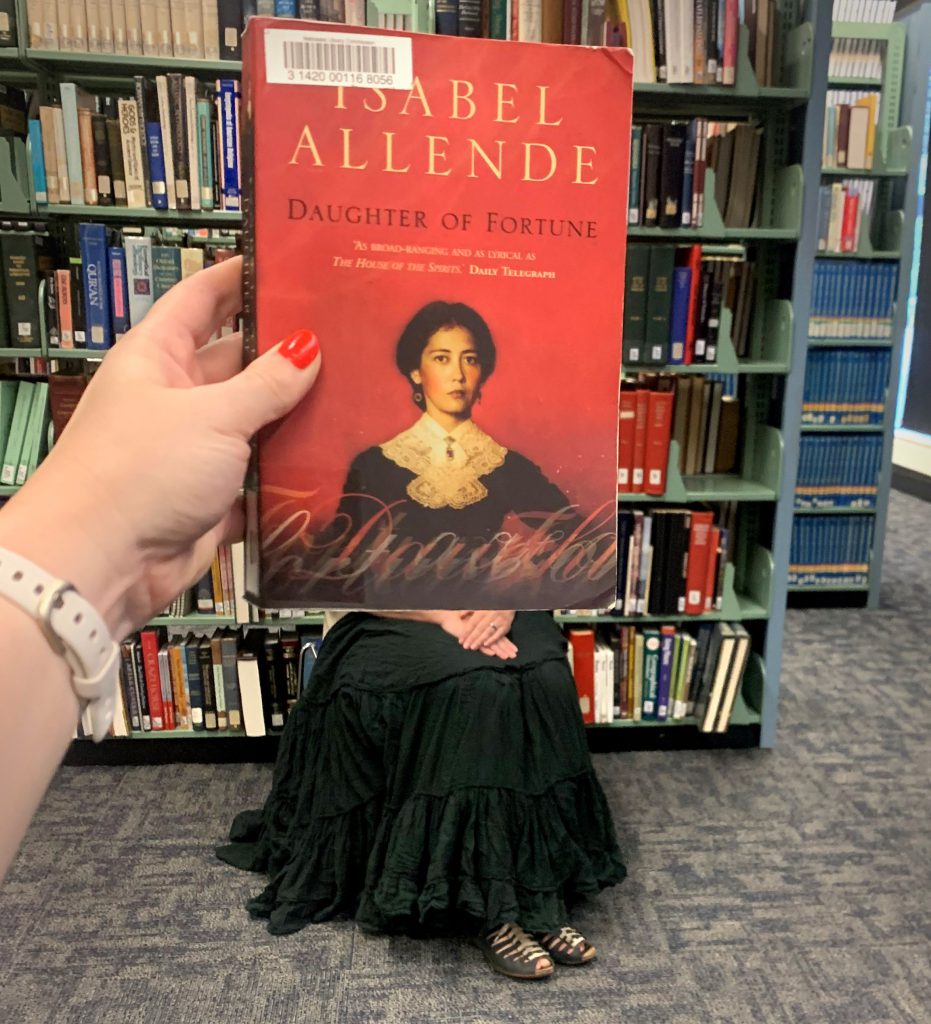
This #BookFaceFriday is written by one of the many talented authors we are celebrating during National Hispanic American Heritage Month (September 15- October 15), Isabel Allende. Set against the backdrop of the 1849 gold rush in California, Daughter of Fortune (Harper Collins, 1999) is available as a Book Club Kit, as well as an audiobook in Nebraska Overdrive Libraries. You can find many more of Allende’s works as ebooks and audiobooks in Nebraska Overdrive Libraries, as well as all of our curated Hispanic Heritage Month collection titles.
“Until Isabel Allende burst onto the scene with her 1985 debut, The House of the Spirits, Latin American fiction was, for the most part, a boys’ club comprising such heavy hitters as Gabriel García Márquez, Jorge Luis Borges, and Mario Vargas Llosa. But the Chilean Allende shouldered her way in with her magical realist multi-generational tale of the Trueba family, followed it up with four more novels and a spate of nonfiction, and has remained in a place of honor ever since. Her sixth work of fiction, Daughter of Fortune, shares some characteristics with her earlier works: the canvas is wide, the characters are multi-generational and multi-ethnic, and the protagonist is an unconventional woman who overcomes enormous obstacles to make her way in the world. Yet one cannot accuse Allende of telling the same story twice; set in the mid-1800s, this novel follows the fortunes of Eliza Sommers, Chilean by birth but adopted by a British spinster, Rose Sommers, and her bachelor brother, Jeremy, after she is abandoned on their doorstep.”
– Margaret Prio, Oprah Book Club
Book Club Kits Rules for Use
- These kits can be checked out by the librarians of Nebraska libraries and media centers.
- Circulation times are flexible and will be based upon availability. There is no standard check-out time for book club kits.
- Please search the collection to select items you wish to borrow and use the REQUEST THIS KIT icon to borrow items.
- Contact the Information Desk at the Library Commission if you have any questions: by phone: 800/307-2665, or by email: Information Services Team
Love this #BookFace & reading? Check out our past #BookFaceFriday photos on the Nebraska Library Commission’s Facebook page!
Throwback Thursday: Greenhouse at the Immanuel Deaconess Institute
Happy #ThrowbackThursday from Nebraska Memories!
This week, we have a black and white photograph, from 1937, showing the interior of the greenhouse at the Immanuel Deaconess Institute, which was located near 34th & Meredith in Omaha, Nebraska.
This image is published and owned by Alegent Health Immanuel Medical Center. This collection shows the rich and well documented history of the buildings, people, and artifacts of the Immanuel Medical Center in Omaha, Nebraska. An archive of thousands of photo, papers, and items has been maintained for over 120 years and carefully stored and housed on the campus of Alegent Health Immanuel Medical Center.
See this full collection and more on the Nebraska Memories archive.
The Nebraska Memories archive is brought to you by the Nebraska Library Commission. If your institution is interested in participating in Nebraska Memories, see http://nlc.nebraska.gov/nebraskamemories/participation.aspx for more information.
Posted in General, Nebraska Memories, Preservation
Tagged Archives, Greenhouse, History, Nebraska History, Nebraska Memories, TBT, Throwback Thursday
Leave a comment
#BookFaceFriday “The Giver” by Lois Lowry
We’re united in our love for this #BookFaceFriday!
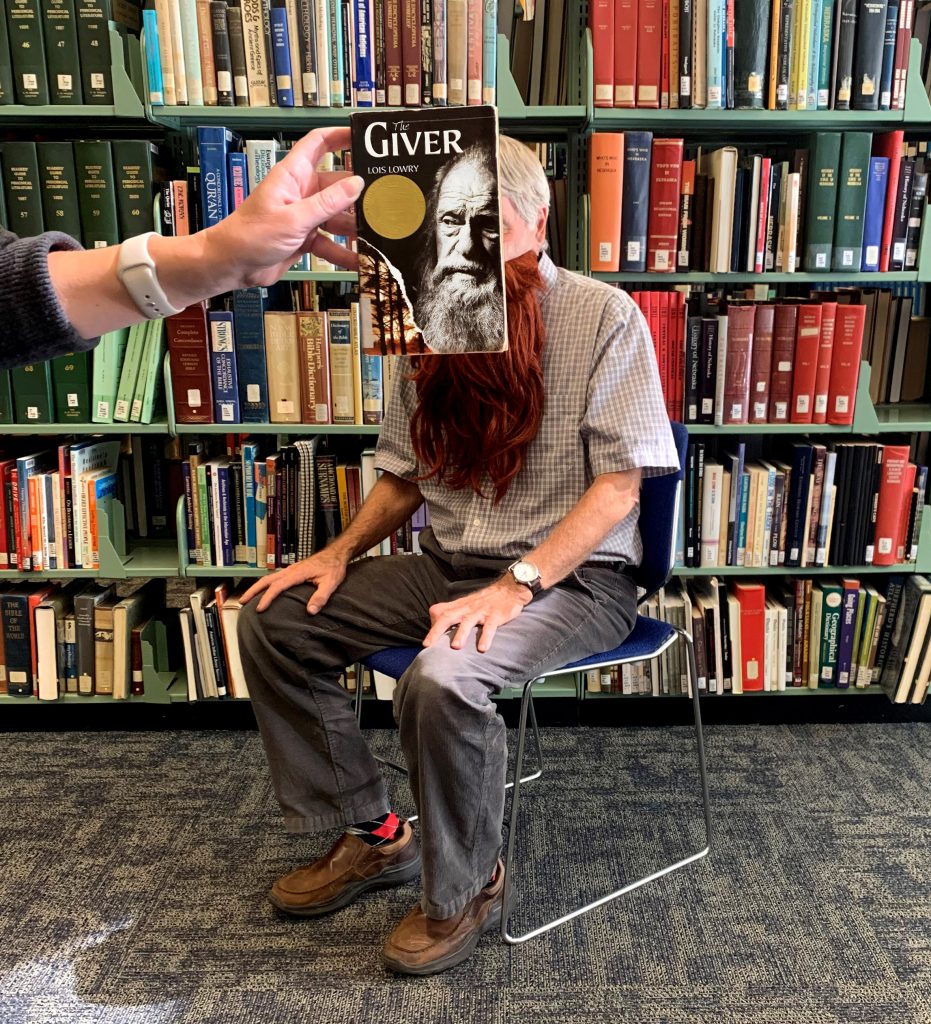
Let Freedom Read! That’s the theme of this year’s #BannedBooksWeek. We are celebrating with a banned #BookFace! The Nebraska Library Commission supports readers and the freedom to read so we make sure our various collections reflect that. “The Giver” by Lois Lowry (Houghton Mifflin, 1993) has been banned or challenged in the US since 1994, less than a year after it’s publication, cited for “violent and sexual passages, infanticide and euthanasia.” The Giver received the 1994 Newbery Medal, given for the most distinguished contribution to American literature for children. It’s available as a book club kit, or as an eBook and Audiobook on Nebraska OverDrive Libraries. A book is considered challenged when calls are made for it to be banned or removed from the public’s access. This is one of many banned or challenged titles NLC has available in our Book Club Kit Collection, titles like Looking For Alaska by John Green, The Absolutely True Diary of a Part-Time Indian by Sherman Alexie, A Wrinkle in Time by Madeleine L’Engle, Beloved by Toni Morrison, and the Harry Potter Series by J.K. Rowling, just to name a few. This week’s #BookFace and other banned books can be found on the NLC Book Club Kit webpage. This service allows libraries and school librarians to “check out” multiple copies of a book without adding to their permanent collections, or budgets. NLC also has several banned or challenged titles available to our Nebraska OverDrive Libraries.
“Lois Lowry has written a fascinating, thoughtful science-fiction novel. The story is skillfully written; the air of disquiet is delicately insinuated. And the theme of balancing the virtues of freedom and security is beautifully presented.”
— Horn Book (starred review)
You can find more information about Banned Books Week and the fight against censorship at ALA.org/advocacy/bbooks! What are you doing to celebrate Banned Books Week? Let us know!
Book Club Kits Rules for Use
- These kits can be checked out by the librarians of Nebraska libraries and media centers.
- Circulation times are flexible and will be based upon availability. There is no standard check-out time for book club kits.
- Please search the collection to select items you wish to borrow and use the REQUEST THIS KIT icon to borrow items.
- Contact the Information Desk at the Library Commission if you have any questions: by phone: 800/307-2665, or by email: Information Services Team
Love this #BookFace & reading? Check out our past #BookFaceFriday photos on the Nebraska Library Commission’s Facebook page!
Posted in Books & Reading, General
Tagged Banned Books Week, Book Club Kits, Book Covers, bookface, bookfacefriday, Lois Lowry, Reading, The Giver
Leave a comment
Throwback Thursday: Wayne State Homecoming 1965
Celebrate Homecoming with #ThrowbackThursday!
This week, we have a black and white photograph featuring John Neihardt at Wayne State College’s homecoming in 1965.
This image is published and owned by Wayne State College. One of three state colleges in Nebraska, Wayne State College, originally the State Normal College at Wayne, held its first session in September of 1910. Photographs included in this collection feature the buildings and grounds of the campus, athletic teams, the Student Army Training Corps, and other groups.
Check out this collection and many more on the Nebraska Memories archive.
The Nebraska Memories archive is brought to you by the Nebraska Library Commission. If your institution is interested in participating in Nebraska Memories, see http://nlc.nebraska.gov/nebraskamemories/participation.aspx for more information.
Throwback Thursday: A.O. Thomas Residence
Happy #ThrowbackThursday from Nebraska Memories!
This week, we have a 5″ x 3-1/2″ black and white photograph showing a large, two story house that belonged to Augustus Orloff Thomas. He served as the first President of Nebraska State Normal School at Kearney. This home was placed on the National Register of Historic Places in 1980 and has been remodeled several times. Now, it serves as the Alumni House.
This photograph from 1908 is published and owned by the Calvin T. Ryan Library at the University of Nebraska at Kearney. UNK was founded in 1905 as the Nebraska State Normal School at Kearney. It joined the Nebraska University system in 1991. Images in this collection show faculty, students, buildings and activities from the first dozen years of the school’s existence.
See the full collection on the Nebraska Memories archive.
The Nebraska Memories archive is brought to you by the Nebraska Library Commission. If your institution is interested in participating in Nebraska Memories, see http://nlc.nebraska.gov/nebraskamemories/participation.aspx for more information.
#BookFaceFriday “The Bromance Book Club” by Lyssa Kay Adams
The first rule of #BookFace: You don’t talk about #BookFace!
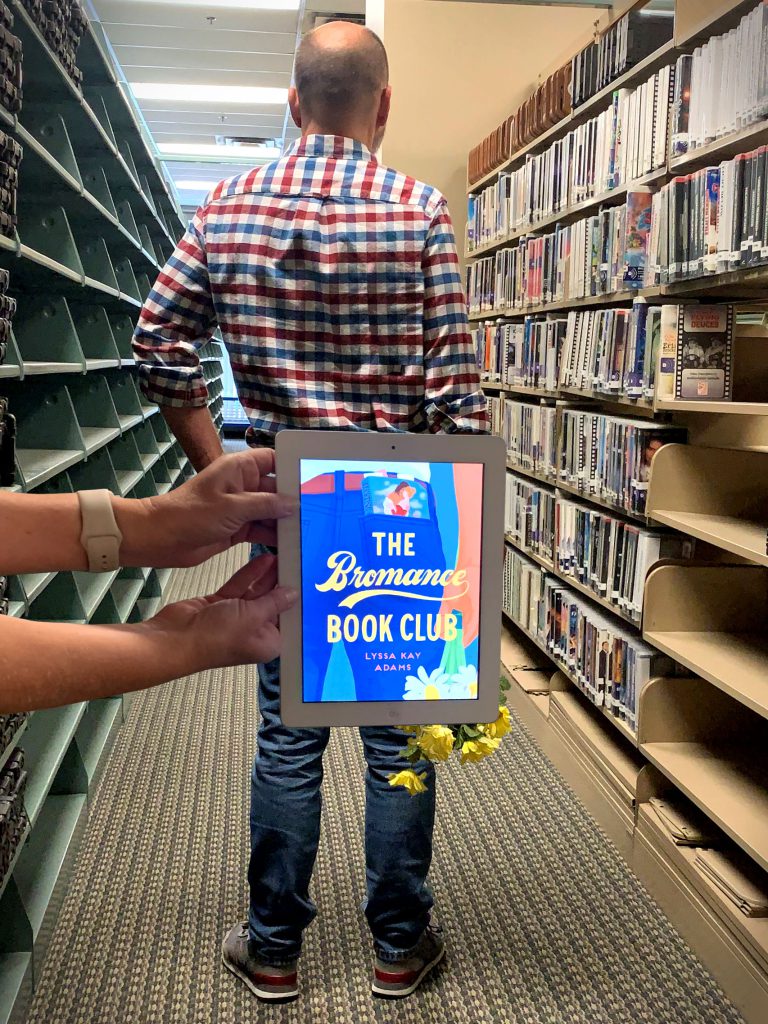
Just kidding – it’s no secret that September is Library Card Sign Up Month! Everyone is welcome at the library, especially book clubs! This week’s title is all about the power of a good book club, “The Bromance Book Club” by Lyssa Kay Adams (Berkley, 2019) is available as both an eBook and Audiobook. Find all the library-themed books in our “Library Card Sign Up Month” collection. There are 200 titles in the collection all about those bookish reads, and even better you can check them out with your library card!
Adams weaves in humor, complex emotions, and excerpts from the motivational story itself to create a satisfying courtship. A strong supporting cast, including Gavin’s book clubmates and his tiny, adorable twin daughters, helps flesh out the Legends community.”
―Publishers Weekly
Find this title and many more through Nebraska OverDrive! Libraries participating in the Nebraska OverDrive Libraries Group currently have access to a shared and growing collection of digital downloadable audiobooks and eBooks. 193 libraries across the state share the Nebraska OverDrive collection of 21,696 audiobooks, 35,200 eBooks, and 3,964 magazines. As an added bonus it includes 130 podcasts that are always available with simultaneous use (SU), as well as SU ebooks and audiobook titles that publishers have made available for a limited time. If you’re a part of it, let your users know about this great title, and if you’re not a member yet, find more information about participating in Nebraska Overdrive Libraries!
Love this #BookFace & reading? Check out our past #BookFaceFriday photos on the Nebraska Library Commission’s Facebook page!
Throwback Thursday: Allen Valish Orchestra
Happy #ThrowbackThursday from Nebraska Memories!
This week, we have a 2″ x 3″ color negative, portrait photograph of the Allen Valish Orchestra. Its members include Mike Palensky, Bill Andel, Bob Palensky, Milo Palensky, Allen Moravec, and Allen Valish.
This image is part of the Boston Studio Project and is owned by the Thorpe Opera House Foundation. The Boston Studio Project consists of over 68,000 negatives that record life in and around David City, Nebraska from 1893 to 1979. Harvey Boston, a professional photographer in David City, owned a portrait studio business from 1893 until his death in 1927. Negatives and ledgers describing each photograph are stored at the Hruska Memorial Public Library in David City.
If you or someone you know likes history, especially Nebraska History, check out the Nebraska Memories archive! It’s a cooperative project to digitize Nebraska-related historical and cultural materials and make them available to researchers of all ages.
The Nebraska Memories archive is brought to you by the Nebraska Library Commission. If your institution is interested in participating in Nebraska Memories, see http://nlc.nebraska.gov/nebraskamemories/participation.aspx for more information.
Take the Nebraska Digital Access and Skills Survey
CONTACT: Ezra Effrein at ezra.effrein@nebraska.gov
FOR IMMEDIATE RELEASE
Take the Nebraska Digital Access and Skills Survey
September 14, 2023 (Lincoln, Neb.) —
How satisfied are you with the quality of your home internet connection? Does your household have enough computer devices available? How confident are you in your internet skills? The State of Nebraska would like to know.The State of Nebraska Digital Opportunities team will be hosting an online survey at https://go.unl.edu/nedigitalequity to gather this data from Nebraskan households. The survey will allow Nebraskans to indicate how many computer devices (laptops, smartphones, or tablets) they have in their home, the quality of their broadband service, their ability to use the internet, and more. The survey must be completed by September 27, 2023.
“I would like to encourage Nebraskans to participate in the survey and help the State of Nebraska better understand and address the digital needs of residents,” said Ed Toner, CIO for the State of Nebraska. “Having access to the internet and appropriate devices, as well as having the digital skills necessary to use these technologies, is becoming necessary to access healthcare, financial services, education, and other necessities.”
The survey, conducted by the University of Nebraska–Lincoln, is a component of the State of Nebraska’s State Digital Opportunities Plan being developed by the Office of the Chief Information Officer in conjunction with the Nebraska Broadband Office’s broadband planning efforts. The development of the State Digital Opportunities Plan is funded through a grant from the National Telecommunications and Information Administration.
“Collecting this data is really the foundation of beginning to understand, prioritize, and formulating solutions to the most important digital needs and skills of Nebraskans,” said Patrick Haggerty, Director, Broadband Office, Nebraska Department of Transportation. “Thank you to the Nebraska Digital Opportunities team and the University of Nebraska for supporting this very important work.”
To learn more about the Nebraska State Digital Opportunities Plan, please visit nitc.nebraska.gov or broadband.nebraska.gov.
What’s Up Doc? New State Agency Publications at the Nebraska Library Commission
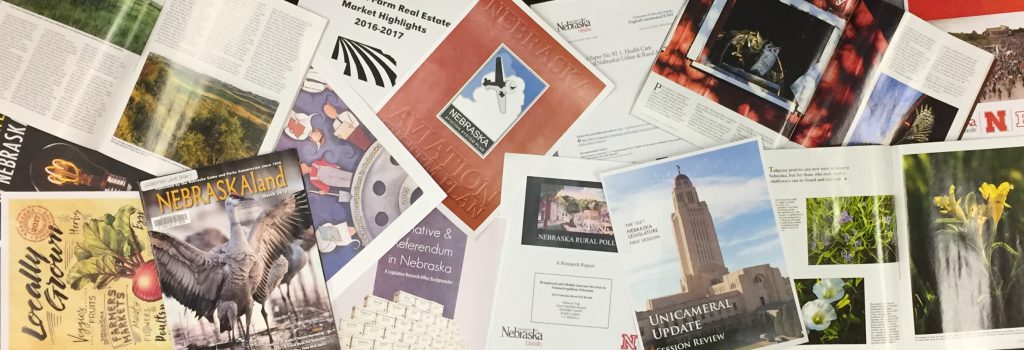
New state agency publications have been received at the Nebraska Library Commission for July and August, 2023. Included are reports from the Nebraska Administrative Services, Nebraska Colleges & Universities, the Nebraska Board of Examiners, the Nebraska Department of Labor, and new books from the University of Nebraska Press, to name a few.
Most items, except the books from the University of Nebraska Press, are available for immediate viewing and printing by clicking on the highlighted link above, or directly in the .pdf below. You can read synopses of the books received from the University of Nebraska Press in the Book Briefs blogposts.
The Nebraska Legislature created the Nebraska Publications Clearinghouse in 1972 as a service of the Nebraska Library Commission. Its purpose is to collect, preserve, and provide access to all public information published by Nebraska state agencies. By law (State Statutes 51-411 to 51-413) all Nebraska state agencies are required to submit their published documents to the Clearinghouse. For more information, visit the Nebraska Publications Clearinghouse page, contact Mary Sauers, Government Information Services Librarian; or contact Bonnie Henzel, State Documents Staff Assistant.
Posted in Books & Reading, Education & Training, General, Information Resources, What's Up Doc / Govdocs
Tagged books, GovDocs, Reading
Leave a comment
Friday Reads: “The Wheel of Time Series” by Robert Jordan
I’ve been reading this series since I was a freshman in high school, and by then the first books were almost 15 years old, so you know they pass the test of time. I’ve been reading and rereading this series off and on ever since. It’s one of my favorite fantasy series, full of flawed characters, adventure, love stories, and tragedies. The first book in the series is The Eye of the World, It follows a group of young adults, childhood friends, as they’re pulled out of the comfortable small village they’ve always known and thrown into a fight between good and evil and the possible destruction of the world as they know it. It’s a long series, 14 books, and Lincoln City Libraries and Nebraska Overdrive Libraries both have all of them in eBook and Audiobook format available on Libby. If you were a fan of Game of Thrones with its multiple character story lines and young heroes and heroines, this is a great series for you. Prime Video came out with a TV series last year, and while I enjoyed it, I will always urge someone to read the books. They are infinitely better.
Jordan, Robert. The Eye of the World. Tor Books. 1990.
Posted in Books & Reading, General
Tagged A Hawthorne and Horowitz Mystery, Anthony Horowitz, Book Review, Friday Reads, mystery, Reading, series, The Word is Murder
1 Comment
#BookFaceFriday “The Bookish Life of Nina Hill” by Abbi Waxman
Read between the lines with this #BookFaceFriday!
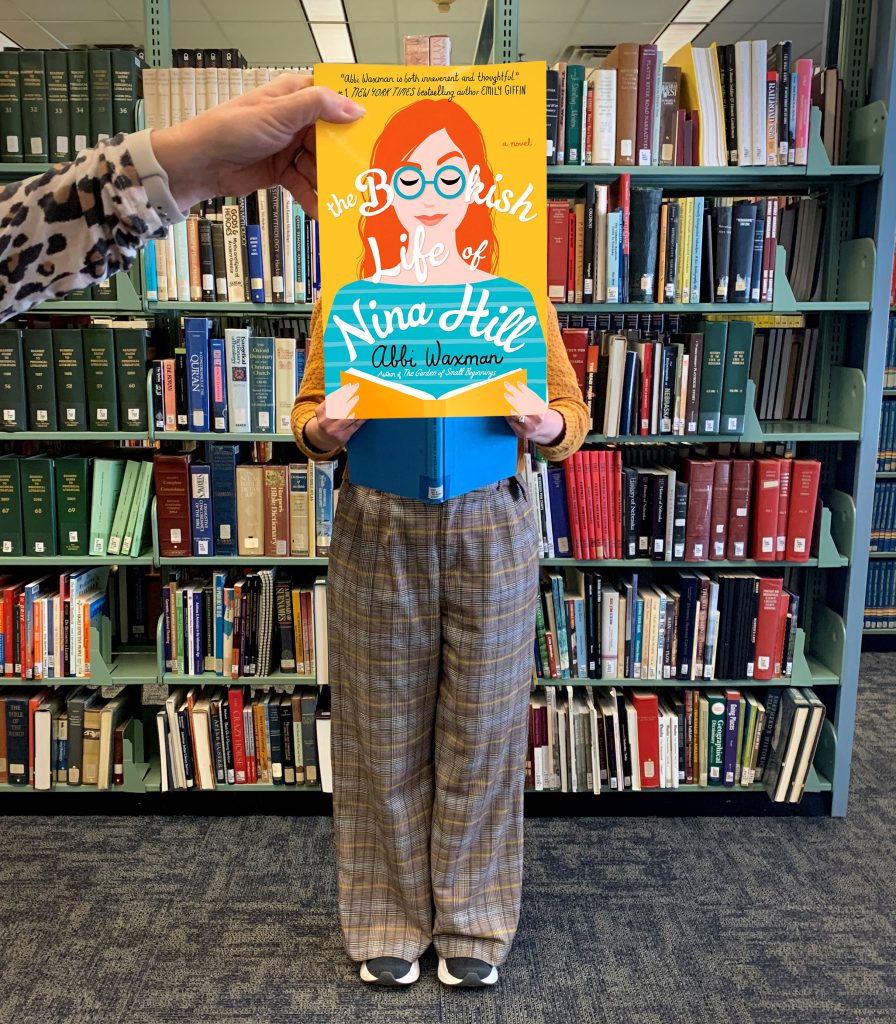
It’s another bookish #bookface for Library Card Sign Up month! A library card gives you access to so many great things, including free ebooks and audiobooks if your local library participates in Nebraska Overdrive Libraries! One such eBook is “The Bookish Life of Nina Hill : A Novel” by Abbi Waxman (Berkley, 2019) – an irreverent novel about a millennial bookworm who lives her life vicariously through books . Find all the library-themed books in our “Library Card Sign Up Month” collection. There are 200 titles in the collection all about those bookish reads, and even better you can check them out with your library card!
“In this love letter to book nerds, Waxman introduces the extraordinary introvert Nina Hill…. With witty dialogue and a running sarcastic inner monologue, Waxman brings Nina to vibrant life as she upends her introverted routine and becomes part of the family. Fans of Jojo Moyes will love this.”
―Publishers Weekly
Find this title and many more through Nebraska OverDrive! Libraries participating in the Nebraska OverDrive Libraries Group currently have access to a shared and growing collection of digital downloadable audiobooks and eBooks. 189 libraries across the state share the Nebraska OverDrive collection of 21,696 audiobooks, 35,200 eBooks, and 3,964 magazines. As an added bonus it includes 130 podcasts that are always available with simultaneous use (SU), as well as SU ebooks and audiobook titles that publishers have made available for a limited time. If you’re a part of it, let your users know about this great title, and if you’re not a member yet, find more information about participating in Nebraska Overdrive Libraries!
Love this #BookFace & reading? Check out our past #BookFaceFriday photos on the Nebraska Library Commission’s Facebook page!
